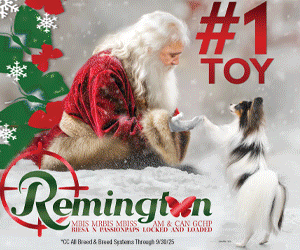A Half-Century in Bulldogs: Jean Hetherington
By Joan Harrigan
 When Jean Hetherington was a baby in northern New Jersey, her parents—no doubt influenced by author Albert Payson Terhune—had a collie named “Laddie.” During WWII, they couldn’t obtain sufficient meat to feed him, so they donated Laddie to the military, and he served the country as a war dog.
When Jean Hetherington was a baby in northern New Jersey, her parents—no doubt influenced by author Albert Payson Terhune—had a collie named “Laddie.” During WWII, they couldn’t obtain sufficient meat to feed him, so they donated Laddie to the military, and he served the country as a war dog.
“After the war, my family always had a dog when I was growing up,” Hetherington recalls. “But we had one at a time, and none were Bulldogs.” Her introduction to the breed came with her marriage to Robert Hetherington, who had grown up with Bulldogs as pets. Cementing his connection to the breed, Bob graduated from Yale, whose mascot is the Bulldog.
“We bought our first Bulldog from Betty and Al Rae in 1962,” Jean Hetherington recalls. “That was Raefair’s Reggie Van Snowball, and with the Raes’ encouragement, we showed him a bit. He won his class fairly often, and that got us hooked.” The Hetheringtons then bought a bitch—Raefair’s Pixie of Hetherbull. Pixie produced their first great winner, Ch. Hetherbull’s Arrogance, who won the Bulldog Club of America National Specialty in 1966, when he was just 2 years old. It was the Hetheringtons’ first litter. just 2 years old. It was the Hetheringtons’ first litter.
“Everyone said ‘well, they won’t be around long,’” she says. “Too much good luck, too fast! Well, after that, we just kept breeding and trying.”
We Learned by Listening, not Talking
While the Raes were their first mentors, the couple also learned a great deal from simply listening to other breeders and exhibitors. “All the shows were benched then, so we had to be at the show until 3 p.m. Bulldog people are known for bringing great food to shows,” she says. “We found the Bulldog community to be welcoming, so we just would just sit around and listen. We formed our own opinions by listening to others.”
Almost 50 years after their first big win, the 100th Bulldog bred by the Hetheringtons has just finished his title. The Bulldogs they’ve owned were always owner-handled, originally by Bob. “I started showing more when shows were scheduled on weekdays, when Bob was working,” Jean says. “Before that, he did most of the handling, and I got the second string!” Jean has never lost her love of being in the ring, and she finds that she is much more nervous watching one of her dogs being shown. The Hetheringtons set the breed BIS record with Ch. Hetherbull’s Bounty’s Frigate, who amassed 52 over his career, as well as multiple specialty wins, including the 1988 BCA Nationals.
Love of Animals Goes Beyond Bulldogs
They owned and showed other breeds, as well—Chow Chows with the late Dr. Sam Draper, three generations of Brussels Griffons, a Pomeranian, and Wirehaired Dachshunds from the late Peggy Westfall. “Peggy and I were good friends—we traveled together and had a lot of fun,” says Jean. “She had a Bulldog from me, and I had a Dachshund from her.” Bob Hetherington always had an Airedale, but not to show—“it’s too much,” his wife says. “The grooming alone—you’ve got to have a handler!”
Since 1996, they’ve lived on 10 acres in Oxford, NC, with Bulldogs and Frenchies—and assorted cows, goats, sheep, poultry, and a mule. The livestock is Bob’s hobby, but the couple plans to downsize and leave their rural home for something closer to Raleigh. “It’s a lot of work, and it’s just getting to be too much,” Jean says.
Both Hetheringtons are judges. Jean is approved for Boston Terriers, French Bulldogs, and Lhasa Apsos, as well as Bulldogs and eagerly anticipates her assignment to judge Bulldogs and Frenchies at Westminster in 2014. “Bob hasn’t judged lately, but he is approved for the whole Non-Sporting group, as well as Best in Show, Toy Poodles, and the Miscellaneous breeds,” Jean says. “He has judged more than I have, but only in the area, as he won’t fly. And, when asked to judge near our home, he often said, ‘oh, Jean would prefer to show.’”
The Hetheringtons were recognized by the AKC as the 2009 Non-Sporting Breeders of the Year. Jean is a member of the Bulldog Club of America’s Hall of Fame, and both she and her husband have served as BCA officers. Bob’s career was in banking—Jean worked in real estate and showed their dogs. Their move to North Carolina was prompted by her work as the AKC Director of Special Services from 1996 to 2006; while working for the AKC, Jean could not judge, and showed only class dogs that she owned.
The Challenges of Breeding Bulldogs
Looking back over her decades of involvement with the Bulldog, Jean Hetherington admits that it wasn’t the easiest breed she and her husband could have chosen. “To start, birth is almost always via cesarean section,” she says. “When we started, anesthesia was not as advanced as it is today, and we often let them try to deliver naturally. We actually had one litter born on the way to the vet; now, vets always schedule the c-section. They don’t want to have to come out to the house in the middle of the night.”
Bulldogs are a breed whose appearance may be its greatest attraction, while at the same time presenting certain challenges. Pet owners are drawn to their droll expression and AKC registrations attest to their growing popularity as pets. In 2002, the Bulldog ranked 18th in AKC registrations—it was 5th in 2012, behind Beagles, Golden Retrievers, German Shepherd Dogs, and perennial favorite over the decade, the Labrador Retriever.
Hetherington describes Bulldogs as “comedians”—always fun to watch in play, and easy to place as an older dog. They bond closely to their people, and are happy as an “only dog.” They are great with kids, she notes, “But I always warn a family with children. This is not a breed that can go outside in the summer to chase a ball. You can’t let them get overheated.”
Bulldog breeders can be taciturn when asked to be interviewed about their dogs. No one will forget The New York Times Magazine’s cover story on September 27, 2011. The cover was a close-up of a Bulldog, with notes and arrows pointing to various areas of the body and possible health concerns. The title was “Can the Bulldog Be Saved?” In the article, writer Benoit Denizet-Lewis focused on the various Bulldogs who served as the mascot of the University of Georgia, and quoted veterinarians, breeders, and pet owners. Denizet-Lewis’ thesis was that this is a breed in danger because of its conformation, and one that needs a redesign.
Responsible Bulldog breeders such as Hetherington were understandably upset by the tone of the article, which they did not think was a fair analysis of their efforts to better the breed. Writers who try to discuss the article with Bulldog breeders often find the discussion quickly terminated. “The BCA now has a committee to speak publicly,” Hetherington explains.
The Origin of the Bulldog, and How the Breed Has Changed
The Bulldog is a breed that has changed over time. The BCA website describes its origin in England, where early Bulldogs helped butchers control animals in slaughterhouses. Until the practice was banned in England in 1835, the breed was also used in bull baiting competitions. The “original” Bulldog would have been less massive than Bulldogs today—and its temperament would have been very different. Today’s Bulldog is a companion, with a disposition the standard describes with adjectives such “equable, kind, pacific, and dignified,” all while retaining its “original courage and resoluteness.”
On its website, the BCA is frank—“this is a highly specialized, man-made breed that would have difficulty surviving on its own in the wild. That’s why they don’t live in the wild. They live with us and we provide for their care.” The BCA advises Bulldog owners to find a veterinarian who is experienced with the breed, and Jean Hetherington agrees.
She firmly believes that the health of the breed has improved over the last 20 years, as the breed has become less extreme in conformation and breeders have focused on health testing their breeding stock. “You don’t see nearly as many huffing and puffing around the ring,” she says. “I remember that years ago, when we first started, you’d see Bulldogs that could hardly make it around the ring. Today, there is less heavy wrinkling over the nose—in the old days, we used to have what I call “rope-y wrinkles, where the skin hangs over the nose and eyes, contributing to breathing issues.”
“There is much more health testing today,” she continues. CHIC (Canine Health Information Center) certification requires four tests—for patellar luxation, congenital cardiac issues, an OFA or CERF eye exam, and a radiographic evaluation for tracheal hypoplasia, a congenital underdevelopment of the cartilage rings in the trachea and narrowing of the airway. A number of other tests are recommended, and Hetherington says that breeders are advertising the extent of their testing.
“The dog’s ability to move around the ring is important,” she says. “And when I am judging, I don’t want to put one up that has pinched nostrils. Frankly, I’ve seen more pinched nostrils in Frenchies lately than I have in Bulldogs.”
Jean is currently showing a Bulldog bitch, Imperious HamItUp Southern Belle, who at a year and a half old, has won 15 specialties. Showing a bitch can be a challenge. “Even though our standard says allowance should be made for the bitch, who is never as “grand” as the dog, there are very few top-winning bitches. They are smaller, their heads aren’t as big, and the judges just tend to pick the dog. In the top 10 Bulldogs, there is only one bitch.”
Popularity Has Its Own Issues
Jean Hetherington believes that the breed has become too popular, which has led to indiscriminate breeding and health issues. “Puppy buyers do not do enough research and too few of them ask questions before they buy. It’s amazing.” she says emphatically. “You see all kinds of weird colors advertised on the internet—merle, blue, black.” These colors are not allowed by the standard, or in case of solid black Bulldogs, considered “very undesirable.” She’s not sure why the breed’s popularity has grown so, though she admits “once you’ve had a Bulldog, you stick with them.”
As to the future of the breed, Jean Hetherington is confident. “Breeders in England have been hit so much harder,” she says. “There, the breed standards are owned by the Kennel Club, which has the ability to change them.” In England, the Bulldog is on the Kennel Club’s “breed watch list” with judges cautioned to watch for characteristics such as difficulty breathing and excessive weight.
“Here, the BCA owns the standard, not the AKC, and I don’t see that the standard will change. We have a lot of members, and they’d need to vote on any changes,” Hetherington concludes.
Over the last ten years, Hetherington hasn’t bred a litter. “I’m too old to stay up all night with them!” she says. At home, she and Bob have three Bulldogs and a Frenchie—all co-owned, so that, “they’ll have a good place to go if something happens to us.”
While the Hetheringtons have contributed much to their beloved breed, when Jean looks back on her half-century with Bulldogs, what she remembers most are their many friends in the fancy. “It’s another family,” she says. “There are so many wonderful friends that I truly feel that I could travel anywhere and have someone I could call for help if I needed them.”
To Read The Complete Article Click Here
Short URL: http://caninechronicle.com/?p=42874
Comments are closed











